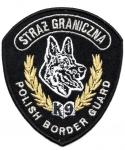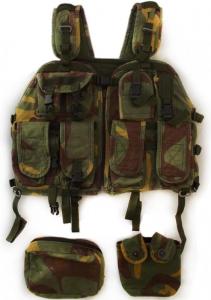Serbia Chest Webbing Camouflage Tactical Vest M-68
Casual:

4th Sustainment Command Patch. US Army

шеврон K-9 Пограничной охраны Республики Польша

Badge of the Armed Forces of the Republic of Belarus 1992 - 1994
To change information
Serbia Chest Webbing Camouflage Tactical Vest M-68
This is vest of one of the nonregulation chest webbing rigs/tactical vests used by Yugoslav and Serbian paramilitary forces during the Yugoslav Wars of the 1990s. The vest is made with extremely tough and resilient M-68 "branch" pattern camouflage material. The distinctive three-color design was the first domestically-produced camouflage pattern to be used by the Yugoslav People's Army (JNA). It comprises large, strikingly-colored brown, green and yellow elements distributed in a branch-like pattern.
When this camouflage was originally introduced, the only items known to have been manufactured in this pattern were scout/sniper over-suits (with a jacket, pants, hood, gloves and carrying bag) and tent shelt halves. But when Yugoslavia disintegrated in 1991, the various warring sides used material from the over-suits and tent shelter halves to produce numerous nonregulation garments and pieces of equipment, including vests like this one, that were later used throughout the Yugoslav Wars.
This particular vest was used by Serbian paramilitaries that took part in the fighting. It is constructed of extremely tough, oil and water repellent webbing and fabric printed in the M-68 "branch" pattern. An equipment belt can be secured to the vest with 6 nylon belt loops that secure the belt to the vest with Velcro strips.
The vest has four permanently attached pouches that can carry a total of four 30-round 7.62 mm magazines for the Serbian M-70 (and later-model) Kalashnikov-style assault rifle. Directly above the magazine pouches are two fragmentation grenade pouches, a radio pouch and what appears to be a knife pouch. All pouches secured with Velcro strips and/or plastic quick-release buckles. The shoulders are additionally protected with foam padding.
The vest closes in front with a tough zipper and a chest strap using a plastic quick-release buckle. There is a large carryall pouch on the back of the vest, as well as two accessory pouches (one for a canteen and the other for miscellaneous pieces of equipment) that can be attached to an equipment belt. The vest's size is adjustable in the sides with special nylon straps. It can be adjusted to fit any size from a Large to XXL.
Because of the plastic quick-release buckles, we do not believe the vest originated during the early conflicts in Croatia and Bosnia (1991-1995), since buckles of that kind were rarely used at that time. It is more likely that the vest originated during the Kosovo War (1998-1999). Our research indicates that vests of this kind were used by Serbian paramilitary groups in Kosovo, especially by the so-called "operational groups" and militias that were used by the Serbian Ministry of Interior Affairs (MUP) to carry out covert actions against ethnic Albanian rebels of the Kosovo Liberation Army (KLA).
This is certainly a rare piece of military history from that period. The vest is in excellent condition, with no visible faults or signs of damage or excessive wear. It is light, durable and could be used again tomorrow. Nonregulation uniforms and equipment used by Serbian paramilitaries are becoming increasingly difficult to find. This is one of the few remaining pieces of that kind in our inventory.
This is vest of one of the nonregulation chest webbing rigs/tactical vests used by Yugoslav and Serbian paramilitary forces during the Yugoslav Wars of the 1990s. The vest is made with extremely tough and resilient M-68 "branch" pattern camouflage material. The distinctive three-color design was the first domestically-produced camouflage pattern to be used by the Yugoslav People's Army (JNA). It comprises large, strikingly-colored brown, green and yellow elements distributed in a branch-like pattern.
When this camouflage was originally introduced, the only items known to have been manufactured in this pattern were scout/sniper over-suits (with a jacket, pants, hood, gloves and carrying bag) and tent shelt halves. But when Yugoslavia disintegrated in 1991, the various warring sides used material from the over-suits and tent shelter halves to produce numerous nonregulation garments and pieces of equipment, including vests like this one, that were later used throughout the Yugoslav Wars.
This particular vest was used by Serbian paramilitaries that took part in the fighting. It is constructed of extremely tough, oil and water repellent webbing and fabric printed in the M-68 "branch" pattern. An equipment belt can be secured to the vest with 6 nylon belt loops that secure the belt to the vest with Velcro strips.
The vest has four permanently attached pouches that can carry a total of four 30-round 7.62 mm magazines for the Serbian M-70 (and later-model) Kalashnikov-style assault rifle. Directly above the magazine pouches are two fragmentation grenade pouches, a radio pouch and what appears to be a knife pouch. All pouches secured with Velcro strips and/or plastic quick-release buckles. The shoulders are additionally protected with foam padding.
The vest closes in front with a tough zipper and a chest strap using a plastic quick-release buckle. There is a large carryall pouch on the back of the vest, as well as two accessory pouches (one for a canteen and the other for miscellaneous pieces of equipment) that can be attached to an equipment belt. The vest's size is adjustable in the sides with special nylon straps. It can be adjusted to fit any size from a Large to XXL.
Because of the plastic quick-release buckles, we do not believe the vest originated during the early conflicts in Croatia and Bosnia (1991-1995), since buckles of that kind were rarely used at that time. It is more likely that the vest originated during the Kosovo War (1998-1999). Our research indicates that vests of this kind were used by Serbian paramilitary groups in Kosovo, especially by the so-called "operational groups" and militias that were used by the Serbian Ministry of Interior Affairs (MUP) to carry out covert actions against ethnic Albanian rebels of the Kosovo Liberation Army (KLA).
This is certainly a rare piece of military history from that period. The vest is in excellent condition, with no visible faults or signs of damage or excessive wear. It is light, durable and could be used again tomorrow. Nonregulation uniforms and equipment used by Serbian paramilitaries are becoming increasingly difficult to find. This is one of the few remaining pieces of that kind in our inventory.



